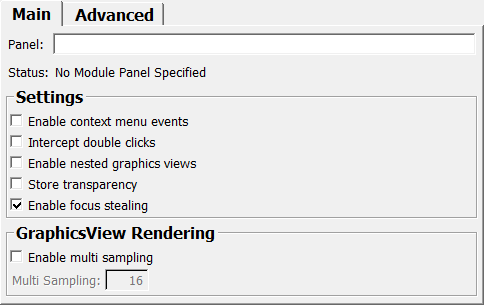RemotePanelRendering¶
- MLModule¶
genre
author
package
dll
definition
see also
Purpose¶
The RemotePanelRendering module is derived from the RemoteRendering module. It allows rendering module panels offscreen, which can be viewed by using a RemoteRenderingClient module or any other remote rendering client (e.g., a web browser).
Usage¶
Add the RemotePanelRendering module to your network and set the Panel value to the module panel that you want to render.
Tips¶
If you have several processes running that use RemotePanelRendering at the same time, you can set the environment variable MLAB_NUMBER_CONCURRENT_PANEL_RENDERING to a number to restrict the number of these modules that render a panel at the same time. This can avoid a GPU bottleneck by serializing the use of the GPU.
Windows¶
Default Panel¶

Output Fields¶
outBase¶
- name: outBase, type: RemoteRendering(MLBase)¶
For accessing this object via scripting, see the Scripting Reference:
MLRemoteRenderingWrapper.
Parameter Fields¶
Field Index¶
|
|
|
|
|
|
|
|
|
|
||
|
|
|
|
|
|
|
||
|
|
Visible Fields¶
Enable Multi Sampling¶
- name: enableMultiSampling, type: Bool, default: FALSE¶
If checked, multi-sample anti-aliasing (MSAA) is enabled. This only works if a GraphicsView is rendered, since it requires OpenGL rendering.
Multi Sampling¶
- name: multiSampling, type: Integer, default: 16¶
Sets the number of multi-sampling samples that are used. If the hardware supports fewer samples, the module will use the maximum supported number of samples.
Store Transparency¶
- name: storeTransparency, type: Bool, default: FALSE¶
If checked, the alpha channel of the framebuffer is enabled and the resulting alpha is sent with the rendered image. This forces the usage of PNG, since JPG does not support transparency.
Intercept Double Clicks¶
- name: interceptDoubleClicks, type: Bool, default: FALSE¶
If checked, the
RemotePanelRenderingmodule will intercept and remove double clicks (including the first click of a double click). This is done by delaying mouse clicks until the double click is received or the double click threshold (time or distance) is exceeded.Be aware that using this feature can disrupt the usual ordering of input events and other messages received from the remote connection.
Enable¶
- name: overrideStreamingQuality, type: Bool, default: FALSE¶
If checked, the module allows for overriding the image type and quality for image streaming.
NOTE: Typically, the client can select the desired type and quality by sending the streaming settings, e.g., from JavaScript or the HTTP URL. If this option is enabled, the quality is set by the server/this module and cannot be set from the client anymore.
Interactive Image Type¶
- name: interactiveImageType, type: Enum, default: JPG¶
Defines the type of the interactive image.
Values:
Title |
Name |
|---|---|
Jpg |
JPG |
Png |
PNG |
Bmp |
BMP |
Webp Lossy |
WEBP_LOSSY |
Webp Lossless |
WEBP_LOSSLESS |
Jpg Alpha |
JPG_ALPHA |
High Quality Image Type¶
- name: highQualityImageType, type: Enum, default: PNG¶
Defines the high quality image type.
Values:
Title |
Name |
|---|---|
Jpg |
JPG |
Png |
PNG |
Bmp |
BMP |
Webp Lossy |
WEBP_LOSSY |
Webp Lossless |
WEBP_LOSSLESS |
Jpg Alpha |
JPG_ALPHA |
Interactive Jpg Quality¶
- name: interactiveJpgQuality, type: Integer, default: 70, minimum: 0, maximum: 100¶
Sets the interactive JPG Quality (0-100).
High Quality Jpg Quality¶
- name: highQualityJpgQuality, type: Integer, default: 100, minimum: 0, maximum: 100¶
Sets the high quality JPG quality (0-100)
Panel¶
- name: panel, type: String¶
Sets the name of the module (and optionally include also the window name) whose panel should be rendered.
The syntax is “modulename[.windowname]”. If windowname is not given, then the default panel is rendered. If you want to render the panel of a submodule, you can use “macroname.submodule.windowname”. In this case, the windowname is required to distinguish between submodule and windowname. The default panel is named “_default”, so you can write “macroname.submodule._default” to get the default panel of a submodule.
There is a special syntax for showing the panel of the parent macro, which is a single “.”. It is also possible to select a specific panel of the parent macro, which is “.windowname”.
Examples:
Value
Meaning
SomeModule
Show the default panel of SomeModule in the same network
SomeModule.someWindow
Show the window named someWindow of SomeModule
SomeModule.SubModule._default
Show the default panel of SomeModule.SubModule
SomeModule.SubModule.someWindow
Show the window names someWindow of SomeModule.SubModule
.
Show the default panel of the parent macro
.someWindow
Show the window named someWindow of the parent macro
parent:someWindow
Show the default panel of the parent macro of the parent macro
parent:SomeModule._default
Show the default panel of the parent macro of the parent macro
Note that “parent:” is one level above the macro in which the RemotePanelRendering is located, which is why there is the special single “.” syntax to specify the direct parent macro.
Status¶
- name: status, type: Enum, persistent: no¶
Shows the status of the
RemotePanelRenderingmodule.
Values:
Title |
Name |
|---|---|
No Module Panel Specified |
NO_MODULE_PANEL_SPECIFIED |
Module Not Found |
MODULE_NOT_FOUND |
Window Control Not Created |
WINDOW_CONTROL_NOT_CREATED |
Window Not Created |
WINDOW_NOT_CREATED |
Rendering |
RENDERING |
Enable Nested Graphics Views¶
- name: enableNestedGraphicsViews, type: Bool, default: FALSE¶
If checked, the support for nested graphics views is enabled.
Enable Focus Stealing¶
- name: enableFocusStealing, type: Bool, default: TRUE¶
If checked, “focus-stealing” behavior is enabled when the mouse enters the remote panel rendering.
This may steal keyboard focus from the client computer if the worker process and client are on the same machine, but it is necessary to ensure that keyboard shortcuts, such as those defined with the accel keyword, function correctly.